Jellyfish Are Taking Over!
Air Date: Week of December 2, 2016
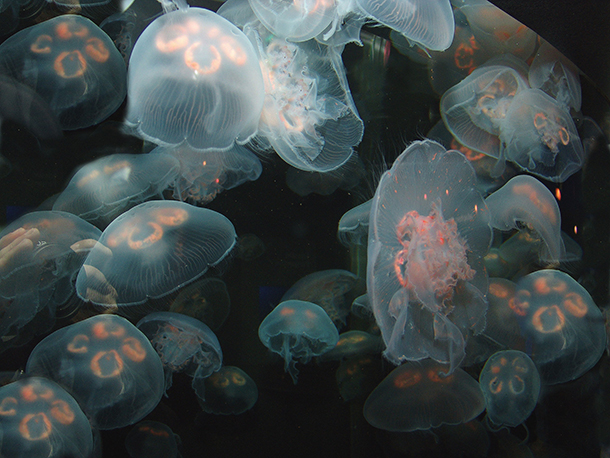
Moon jellies are named for their translucent, moonlike circular bells. (Photo: New England Aquarium)
Dr. Lisa-ann Gershwin has a passion for the jellyfish she studies, and has discovered 200 new species. But the sea creatures she loves are blooming, clogging power plant ducts and beaches as well as overwhelming some marine ecosystems, and even stinging us! And it’s largely because of human impacts like overfishing, plastics pollution, and warming oceans. Living on Earth’s Helen Palmer took a trip to the New England Aquarium to find out more.
Transcript
CURWOOD: Most ocean species that are affected by humans are being harmed, not helped, by our presence. From overfishing to bycatch, to plastic pollution, to warming ocean temperatures, we’re changing the oceans in ways that are reducing the populations of everything from tuna to Right Whales to dolphins. Yet it appears that these threats to the very survival of many marine species may actually be helping one class of sea life: jellyfish. Australian–based biologist Lisa-ann Gershwin has a rare passion for this slimy, slippery, stinging sea-creature. In fact, she's personally identified 200 new species and is one of the foremost experts on these intriguing, but hardly cuddly beings. Speaking to Lisa-ann Gershwin at the New England Aquarium, Living on Earth’s Helen Palmer asked her what is so fascinating about jellyfish.
GERSHWIN: Oh, heavens. What's not? [LAUGHS] I'm drawn to several features about them. I love how beautiful they are. There's just something dreamy and otherworldly and mesmerizing about jellies and I've been drawn to that since the very first time I laid eyes on them. But as a scientist, I'm also drawn to how different they are and how unknown they are and they're incredibly primitive beings. You know, They've been around for a half a billion years, and that's pretty interesting. They've got a lot of aspects of their biology and ecology that are just fascinating, and yet they're so poorly studied and so poorly known that it's like every time you look at them you can discover amazing new stuff, and I really like that aspect as a scientist to be able to make so many discoveries of new species, new behaviors, new aspects of biology and ecology. It is kind of addictive to discover new stuff.
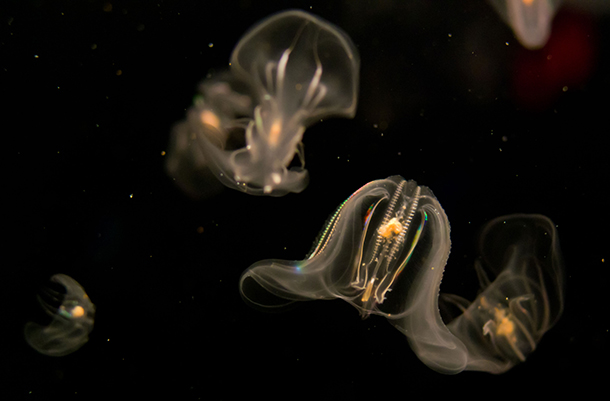
Comb jellies are actually in a separate taxonomic phyla (Ctenophora) than jellyfish (Cnidaria). (Photo: New England Aquarium)
PALMER: So, jellies, you call them jellies?
GERSHWIN: Yeah, jellies or jellyfish.
PALMER: Well, you say there's so much about them. They are indeed very strange, they look like nothing else. How do they work? How do they function?
GERSHWIN: Well, they function in ways that we simply can't relate to. They have no brain, no blood, no heart, no bones. Pretty much they’re just a bag of goo with a stomach and a really primitive nerve net and gonads. That's it.
PALMER: Gosh. So there are many, many, many of them and basically they all alike, they're these pulsating things that get around by taking in water and squeezing out water?
GERSHWIN: Well, no they're not. So, some of them have the umbrella sort of body with the hanging down tentacles and all that, and others have these really weird shapes that defy imagination called Comb jellies -- comb like comb your hair -- and they have these eight rows of cilia and refract the light into rainbows.
PALMER: Cilia are -- little fingers?
GERSHWIN: Yeah, little kind of...little hairs, and these they have these weird little plates of cilia and when the plates beat all rhythmically that's how they move. So, they don't go pulse, pulse, pulse like familiar jellies do. The comb jellies...it's more like tractor motion of these ciliary plates, and they send out these beautiful rays of light. They're just dreamy little things. But they are absolutely alien, and I mean, if believed in these beings from outer space, they would be it because they're weird. Some of them look like Klingon attack vessels, and some of them look like the batman logo, and some of them look like belts, and some of them look like a grape with two tentacles. Like, come on. How could you not love these?

The sting of the flower hat jelly is painful and leaves a bright rash. (Photo: New England Aquarium)
PALMER: Of course, we know jellyfish because we meet them in the sea and it's, "Ow!"
GERSHWIN: They do sting.
PALMER: Do all of them sting?
GERSHWIN: Just about all of them. Almost all jellyfish species have stinging cells, but many of the species that do have stinging cells, they're not able to inflict damage on us with a sting. Some are fairly mild, some are a little bit more ouchy, and some are fully, screamingly painful, and of course, some are actually deadly.
PALMER: You say they're half a billion years old. Have they changed vastly over that period of time, or don't we know because obviously they don’t persevere in the fossil record?
GERSHWIN: No, they do. That's what is so interesting. They do make fossils. They don't leave big meaty fossils like dinosaur legs. It's more like a footprint, and the fossils they leave do tell us quite bit about what they looked like, and the amazing thing is they look and act just like modern-day jellies. So, no they haven't changed and I find this absolutely fascinating. So if you think about -- since jellyfish have been around, about 585 million years that we know from fossil evidence, and about a billion years that we know from DNA evidence, so we know they've been around for a long, long, time and so this is what's so fascinating to me is that while other things have evolved into this staggering array of life. We've got things that swim, we've got things with fins, we've got things that have grown legs, we've got things that have walked on land and learned to breathe, we've got things that have created fur and feathers and wings and they've learned to fly, all this incredible array of animal life that has evolved in that time since jellyfish first swam the seas or well, drifted really, and they haven't changed because haven't needed to. So what they do works. It's that simple, but what's really amazing even more than that is what we are doing as a normal part of being human, you know, our waste and our coastal construction and our fishing and our carbon dioxide, all of these things. We are creating a world for jellyfish that they're loving. We are giving them the biggest break of their entire history.
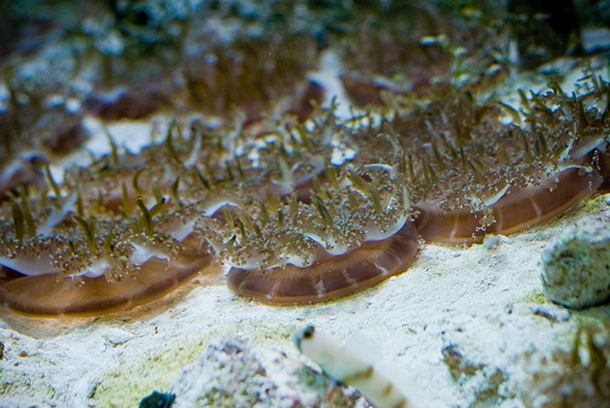
The “upside down jelly” is so named because it spends its life pulsing upside-down in shallow water, rather than swimming through the water. (Photo: New England Aquarium)
PALMER: I was going to ask you, in fact, what is the ideal circumstance for jellyfish? What would be an ideal sort of habitat for jellyfish? You tell me that we've basically created that for them. So what is it?
GERSHWIN: Absolutely, yeah. If you think about, if you're an animal and every day is a struggle to find food, a struggle not to be someone else's food, a struggle to grow fast enough to reproduce before you become food or die of some other way, imagine a world where somebody else does you the favor of taking out your predators and competitors. Well, that's pretty cool. And imagine a world where somebody else warms up the water that you're living in so you grow faster, eat more -- of course there's more food available because the competitors are gone, right -- you reproduce more and you live longer to do more of it. You would be pretty happy. Jellyfish don't have a brain, so I think they're not actually happy right, but man, they're loving it.
PALMER: So, we've basically done so much fishing of the top predators that the things that ate jellyfish aren't there so much anymore.

The sting from Pacific sea nettles causes pain similar in intensity to that of a bee sting. (Photo: New England Aquarium)
GERSHWIN: Yeah, so you think about jellyfish are eaten by turtles. Well, we've taken a lot of turtles, and a lot of turtles have died not necessarily only from fishing but by having less food available and by plastic and beaches having lights, and we're creating a world that's pretty hostile to turtles. So, fewer turtles more jellies. There's a fair few types of fish that only eat jellyfish, but we seem to be taking those out too, and a lot of crabs that eat jellyfish, and we're taking those out too -- like the Blue Swimmer crabs that's everybody's favorite crab. Yeah, those eat jellyfish, but we take a lot of those out.
PALMER: Well, I think many of us who have been swimming to our favorite swimming holes have discovered you can't go in because what's there? Lots and lots and lots of jellyfish. There really is a plague of jellyfishes.
GERSHWIN: They are having a renaissance in many, many places. Of course, not every place has been overrun by jellies of course, and of course not every species of jellyfish is absolutely rambunctious and out-of-control. Some species are actually suffering from the changes we're causing in the environment, but there are some jellies that are doing really, really, really well, and they're just causing untold problems for all sorts of marine industries from tourism where they are stinging people or people are afraid of being stung to power plants that are having emergency shutdowns to salmon farms to fishing vessels and, of course, ecosystems that are being taken over with jellyfishes as the top predator and just bends your mind backwards. Like you think about, hang on, jellyfish is the top predator...what about fish and sharks and whales? It's not that they're eating sharks, but they eat the food that the food of the food of sharks would eat, and so jellyfish are able to cripple an ecosystem at the ankles.
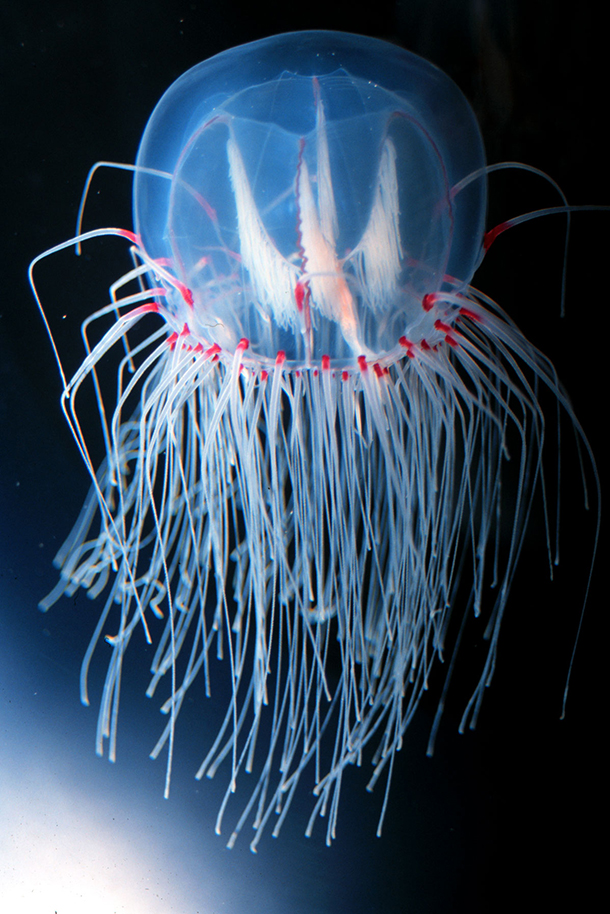
The bell jelly is not a true jelly but rather is a hydromedusa. (Photo: New England Aquarium)
PALMER: So, they basically are eating the plankton, which would've fed the little fish which would've fed the bigger fish which would've fed the shark?
GERSHWIN: That's exactly right...or maybe one or two more levels in there, but yes, jellyfish are eating the eggs and larvae of a quite large species and they also eat the plankton that the larvae would eat. So, yeah this double whammy of creation competition is pretty incredible, simple but incredible.
PALMER: Now there're other problems the jellyfish cause, in particular, why did they cause problems for power plants?
GERSHWIN: Yeah, so power plants seem to be a really interesting thing with jellies. So basically it goes like this. You got a power plant, might be nuclear might be coal-fired might be whatever, but if it draws cooling water from the ocean or an estuary, or anything where jellyfish could conceivably be, when jellyfish bloom into super abundances these power plants suck in all these jellies and the engines that are cooled by the sea water shut down. It could be potentially catastrophic if the plant weren't shut down proactively.
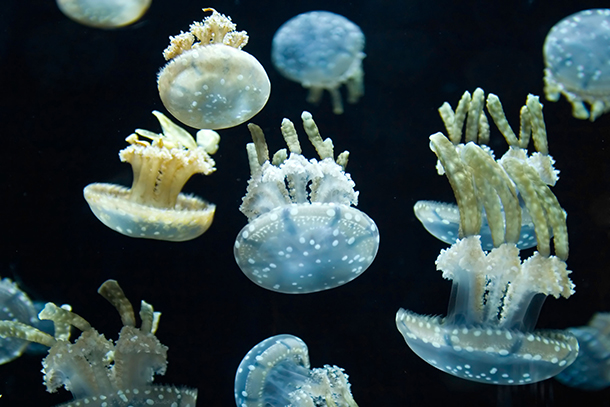
Lagoon jellies feed on zooplankton but also grow symbiotic algae in their tissues as an added food source, giving them a greenish-brown color. (Photo: New England Aquarium)
PALMER: So we have managed to create for ourselves a real problem with these creatures that you really love. What can we do about it?
GERSHWIN: Well, I get this question a lot as you might imagine. There are people making a lot of money developing products based on jellyfish to stimulate fishing of jellyfish, and I say, "Go for it." Seriously, I think it's great. I don't have any problem with that. Some of them are a bit misguided, but I mean, we have to learn that way, right, but there are some that I think are really good products that are useful and I'm completely supportive.
PALMER: Things like...
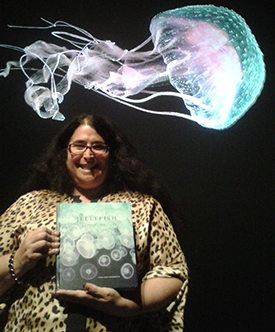
Dr. Lisa-ann Gershwin is the author of Stung!: On Jellyfish Blooms and the Future of the Ocean and has discovered 200 species of jellyfish. (Photo: Helen Palmer)
GERSHWIN: Things like paper towels, you know, jellyfish are highly absorbent. Things like a fat free egg replacement for baked goods. So some of these things are actually quite interesting, and of course, Asian cuisines have been using jellyfish as a delicacy for thousands of years, but I don't think it'll change the fact of the blooms. Even if they fish out a particular species, the next one in line will take its place. I think if we really want to change this dynamic, we have to actually change the reasons the jellyfish are blooming.
They're not blooming because they're evil. They bloom as a natural part of their lifecycle, and they respond to environmental conditions. They're blooming because the things that we are doing as humans is giving them the perfect conditions to bloom. So, as long as we keep giving them fewer fish, warmer water, more nutrients in coastal ecosystems, more coastal construction, etcetera, etcetera, they're going to continue to bloom because that's what they do.
CURWOOD: Lisa Ann Gershwin, in conversation with Living on Earth’s Helen Palmer. For photos of the Rainbow Comb jellies and other species, visit our website, LOE.org.
Links
Smithsonian Institute: Jellyfish and Comb Jellies
Bloomberg: “Massive Swarms of Jellyfish Are Wreaking Havoc on Fish Farms and Power Plants”
Living on Earth wants to hear from you!
Living on Earth
62 Calef Highway, Suite 212
Lee, NH 03861
Telephone: 617-287-4121
E-mail: comments@loe.org
Newsletter [Click here]
Donate to Living on Earth!
Living on Earth is an independent media program and relies entirely on contributions from listeners and institutions supporting public service. Please donate now to preserve an independent environmental voice.
NewsletterLiving on Earth offers a weekly delivery of the show's rundown to your mailbox. Sign up for our newsletter today!
 Sailors For The Sea: Be the change you want to sea.
Sailors For The Sea: Be the change you want to sea.
 The Grantham Foundation for the Protection of the Environment: Committed to protecting and improving the health of the global environment.
The Grantham Foundation for the Protection of the Environment: Committed to protecting and improving the health of the global environment.
 Contribute to Living on Earth and receive, as our gift to you, an archival print of one of Mark Seth Lender's extraordinary wildlife photographs. Follow the link to see Mark's current collection of photographs.
Contribute to Living on Earth and receive, as our gift to you, an archival print of one of Mark Seth Lender's extraordinary wildlife photographs. Follow the link to see Mark's current collection of photographs.
 Buy a signed copy of Mark Seth Lender's book Smeagull the Seagull & support Living on Earth
Buy a signed copy of Mark Seth Lender's book Smeagull the Seagull & support Living on Earth

